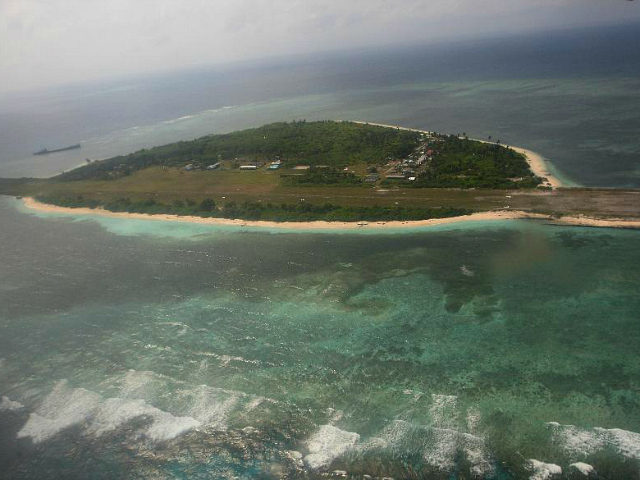This morning’s key headlines from GenerationalDynamics.com
- Chinese vessels massing near Philippines island in South China Sea
- Official warns may be necessary to invoke US-Philippines mutual defense treaty
Chinese vessels massing near Philippines island in South China Sea

Philippines Supreme Court justice Antonio Carpio says that the government must confront China now. Carpio helped the Philippines win the Hague Tribunal ruling that declared illegal China’s activities in the South China Sea
A statement by Philippines Supreme Court Senior Associate Justice Antonio Carpio warns that government must act in response to an “invasion of Philippine territory by China” in the South China Sea.
The warning was triggered when Rep. Gary Alejano said that the military reported early last week that Chinese vessels appeared to be massing north of Pag-asa Island (Thitu Island), a Philippine territory. The Philippines maintains a small population of about 100 people on Pag-asa Island in order to guarantee that it maintains its sovereignty.
Images released by the Asia Maritime Transparency Initiative (AMTI) confirm the military’s information, showing nine Chinese fishing vessels and two Chinese Navy ships near Pag-asa island. According to AMTI:
The number and rapid coordination of naval and coast guard ships suggests that this was purposely organized in advance and was not just an ad hoc response by government vessels that happened to be in the area.
AMTI has repeated used satellite images to prove that China is continuing land reclamation activities, building artificial islands, and creating large military bases. These activities are all illegal under international law since July 2016 when a Tribunal at the United Nations Permanent Court of Arbitration in the Hague eviscerated all of China’s claims to the South China Sea. Since then, China has continued its criminal activities and has continued to annex regions of the South China Sea belonging to other countries, as Hitler did in 1939.
In October of last year, Philippines president Rodrigo R. Duterte traveled to Beijing and announced:
Your honors, in this venue, I announce my separation from the United States. Both in military… not maybe social, but economics also, America has lost. I will be dependent on you.
…
I’ve realigned myself in your ideological flow and maybe I will also go to Russia to talk to Putin and tell him that there are three of us against the world — China, Philippines and Russia.
Americans are loud, sometimes rowdy. Their larynx is not adjusted to civility.
And that statement was made at a time when Barack Obama was president, not Donald Trump.
At the time of that statement, I said this new relationship would not last long because the Philippine people like and trust the United States, while they dislike and distrust China. Duterte’s statement has been highly controversial in the Philippines, and Duterte has been forced to backtrack in some ways.
Ever since then, it has been official government policy that China and the Philippines are friends. That is why Foreign Affairs Secretary Alan Peter Cayetano ridiculed the concerns about Chinese vessels massing near Pag-asa Island, saying “China is not the enemy of the Philippines.” ABS-CDN (Manila) and Asia Maritime Transparency Initiative (AMTI)
Related Articles
- Philippines leader Rodrigo Duterte in comic dance with China (23-Oct-2016)
- Philippines humiliates China in harsh Hague Tribunal ruling over South China Sea (13-Jul-2016)
- Would America not defend Israel after all? (08-Sep-2013)
Official warns may be necessary to invoke US-Philippines mutual defense treaty
Supreme Court Senior Associate Justice Antonio Carpio raised the stakes on Saturday by describing China’s actions as a “invasion of Philippine territory.” He said:
This means China is now virtually occupying a new geologic feature within the territorial sea of Pag-asa, a Philippine territory, in clear violation of China’s supposed vow not to occupy any more islands in the Spratlys. This is worse than what happened in Scarborough Shoal. Sandy Cay is a newly-created island and could not have been owned by China even under its discredited historic nine-dashed line claim. Sandy Cay emerged within the territorial sea of a Philippine territory. If Sandy Cay becomes Chinese territory, it will reduce by a third or more Pagasa’s territorial sea. It will also prevent the Philippines from extending the territorial sea of Pagasa to include Subi Reef. By any yardstick, this is seizure of Philippine territory.
…
It is the constitutional duty of President Duterte, and DFA Secretary Cayetano, to defend and protect Philippine territory. Both have vowed to the Filipino people that they will not concede a single inch of Philippine territory to China.
…
If both are courageous, they should send a Philippine navy ship to guard Sandy Cay, and if the Chinese navy ships attack the Philippine navy vessel, they should invoke the Philippine-US Mutual Defense Treaty.
Carpio was part of the team that won the Hague Tribunal ruling last year that declared illegal China’s activities in the South China Sea.
According to Philippine media, there are now known discussions at the US Pentagon about putting the contested Scarborough Shoal under the 1951 Philippine-US Mutual Defense Treaty, which requires each party to defend the other in the case of an external attack on its territory. Rapplier (Manila) and Asia Times and Inquirer (Manila)
Related Articles
- Philippines President Duterte seeks to appease China at ASEAN meeting (27-Apr-2017)
- Philippines president Duterte orders military to occupy South China Sea islands (07-Apr-2017)
- US will upgrade Philippines military bases, despite Duterte’s threats (31-Jan-2017)
KEYS: Generational Dynamics, Philippines, China, Antonio Carpio, Gary Alejano, Pag-asa Island, Thitu Island, South China Sea, Rodrigo R. Duterte, Alan Peter Cayetano, Sandy Cay, United Nations Permanent Court of Arbitration, 1951 Philippine-US Mutual Defense Treaty, Scarborough Shoal
Permanent web link to this article
Receive daily World View columns by e-mail

COMMENTS
Please let us know if you're having issues with commenting.